There are many creative recipes out there for Vegan Sushi, repurposing everything from watermelon to tomatoes to konjac. Here I’ve rounded up the best homemade options, plus some storebought vegan sashimi that I’ve tried. Plus, jump to the bottom for a bonus recipe for Vegan Chirashi Don.
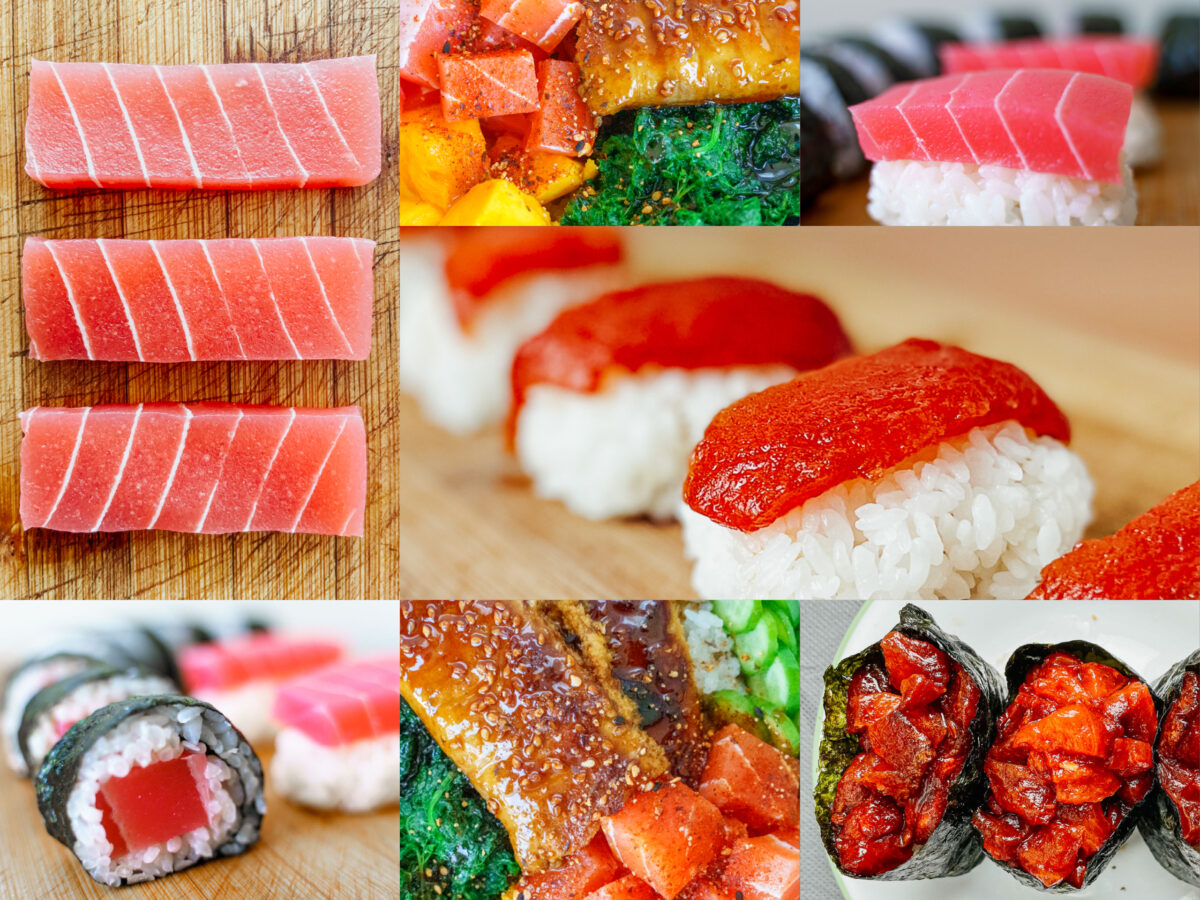
Intro
I used to love eating seafood, especially sushi. Unfortunately, although faux meats are now plentiful in many supermarkets, vegan fish isn’t quite there yet. You’d be hard pressed to find vegan sashimi or vegan nigiri in a big box grocery store. Luckily, there are recipes out there for veggie sushi, and a few brands are starting to offer vegan seafood too.
If you’re craving sushi, I hope this guide helps you satisfy that craving, whether you make it at home or buy it from the store. And make sure to pair with a bowl of miso soup (such as this Bok Choy Miso Soup) for a lovely Japanese meal!
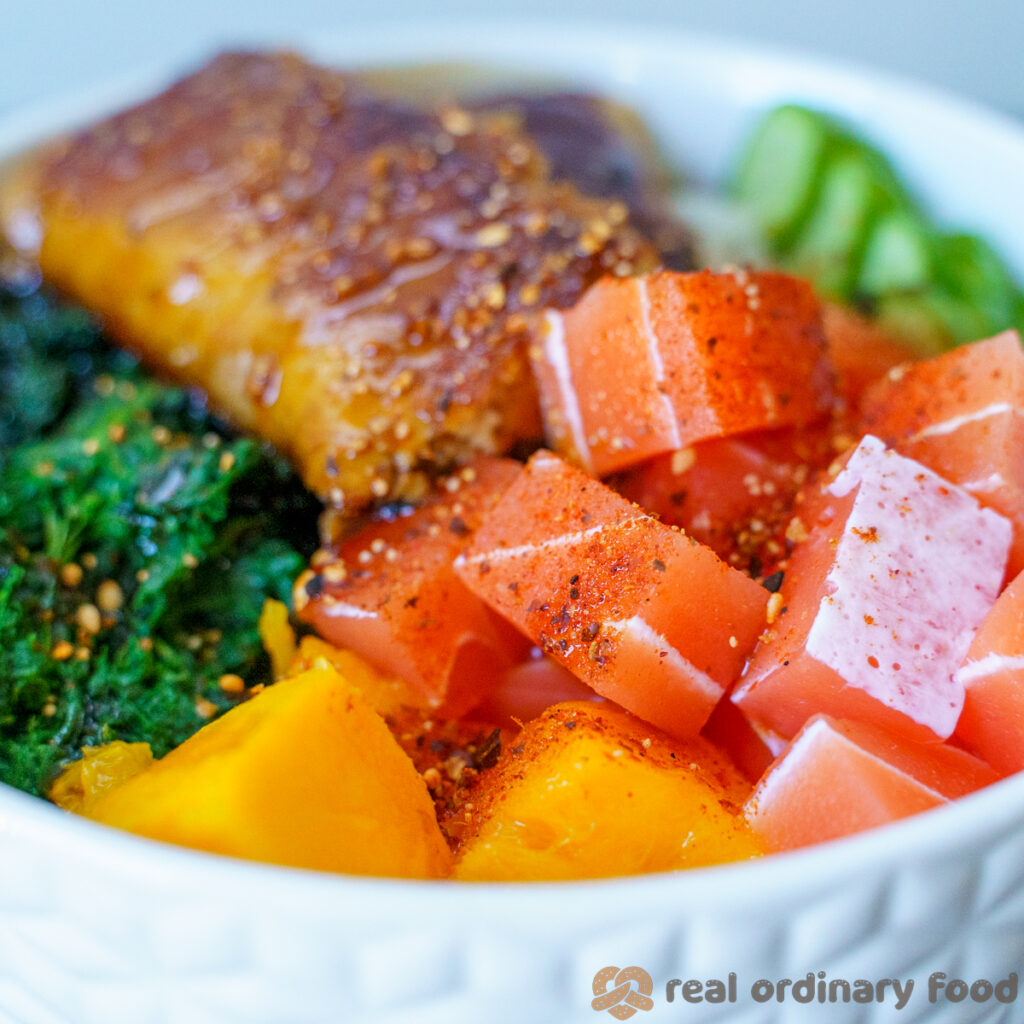
Vegan Nigiri & Sashimi
Sashimi and nigiri are two terms that are often confused for each other. Sashimi (刺身) refers to the piece of fish by itself, while nigiri (握り寿司) refers to fish placed on a piece of rice. The recipes below are for vegan sashimi, though the pictures show nigiri.
Tomato Tuna Sashimi
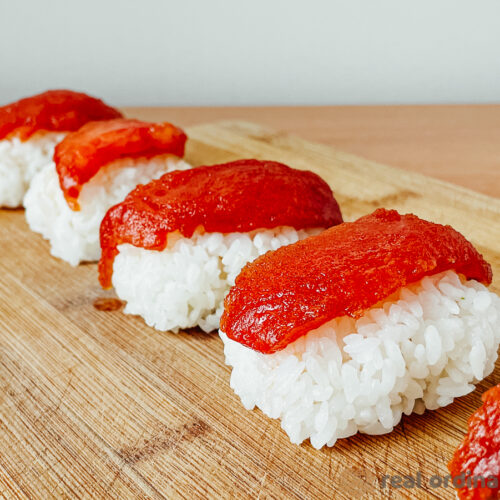
Vegan Konjac Sashimi

Watermelon Tuna

Sushi Rolls (Maki)
Makizushi (巻き寿司), or “rolled sushi,” is your typical sushi roll: nori seaweed and rice wrapped around a piece of filling. And no, you don’t need a bamboo sushi mat to roll them up! Simple but delicious.
Hosomaki
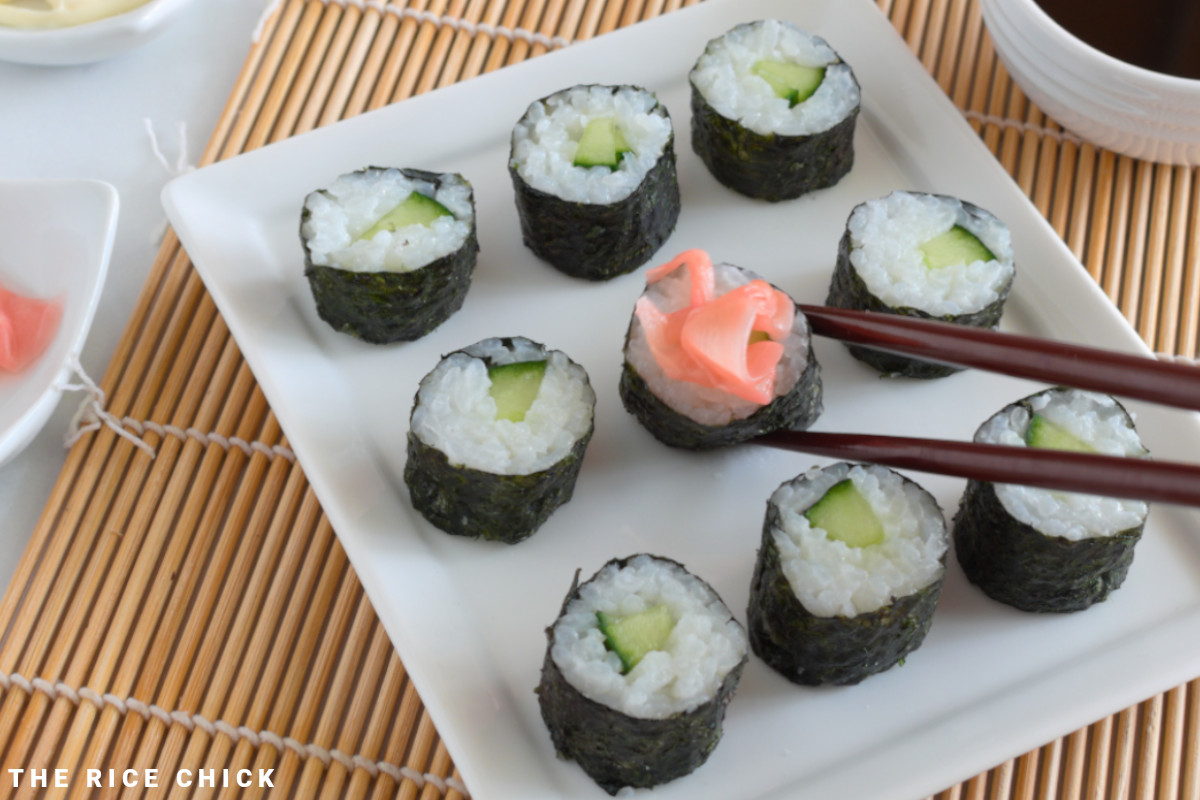
Sweet Potato Sushi Rolls

Tofu Sushi
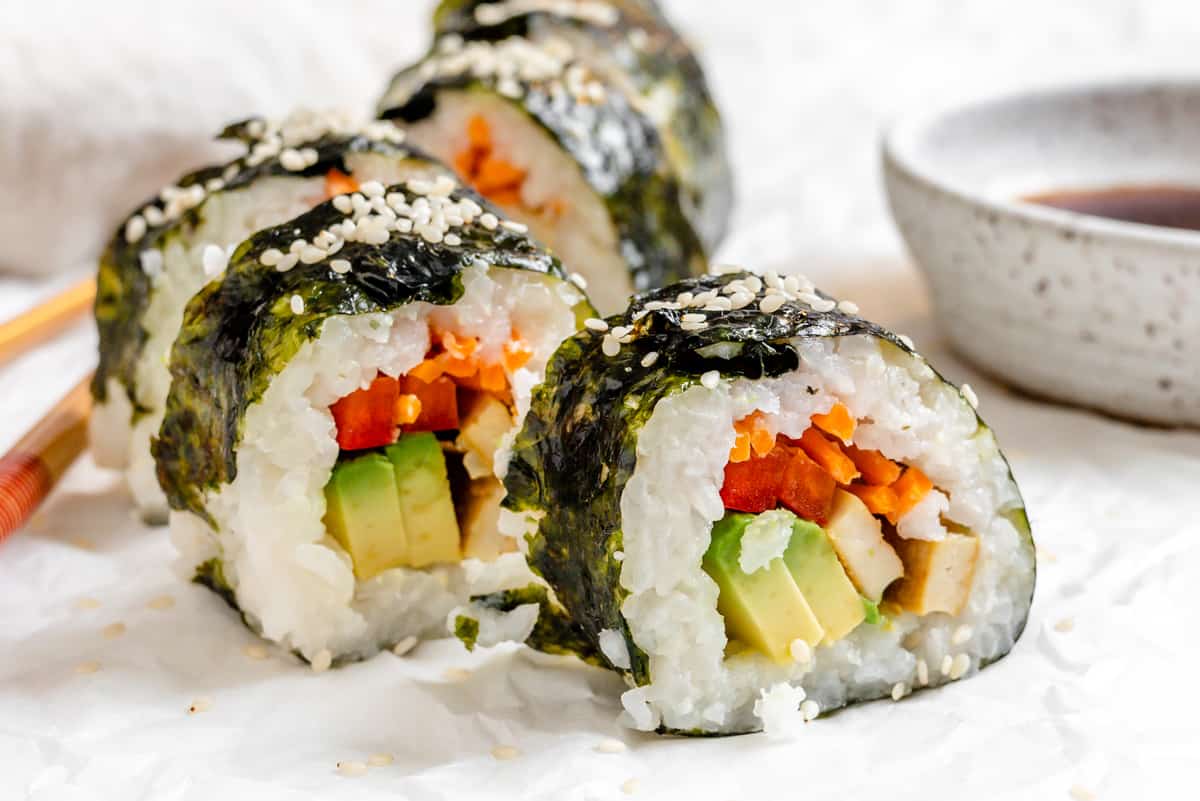
Avocado Maki Rolls

Marinated Konjac Maki Sushi Rolls
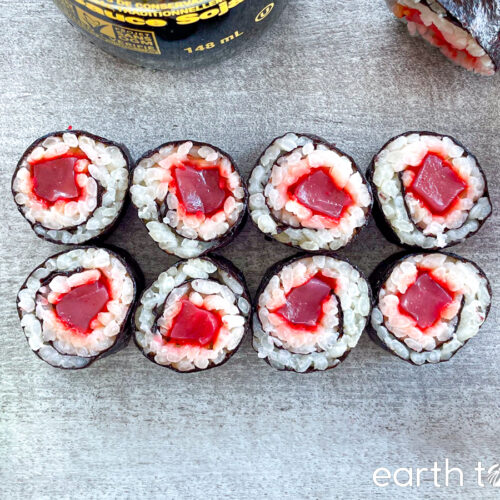
Smoked Tofu Sushi Rolls
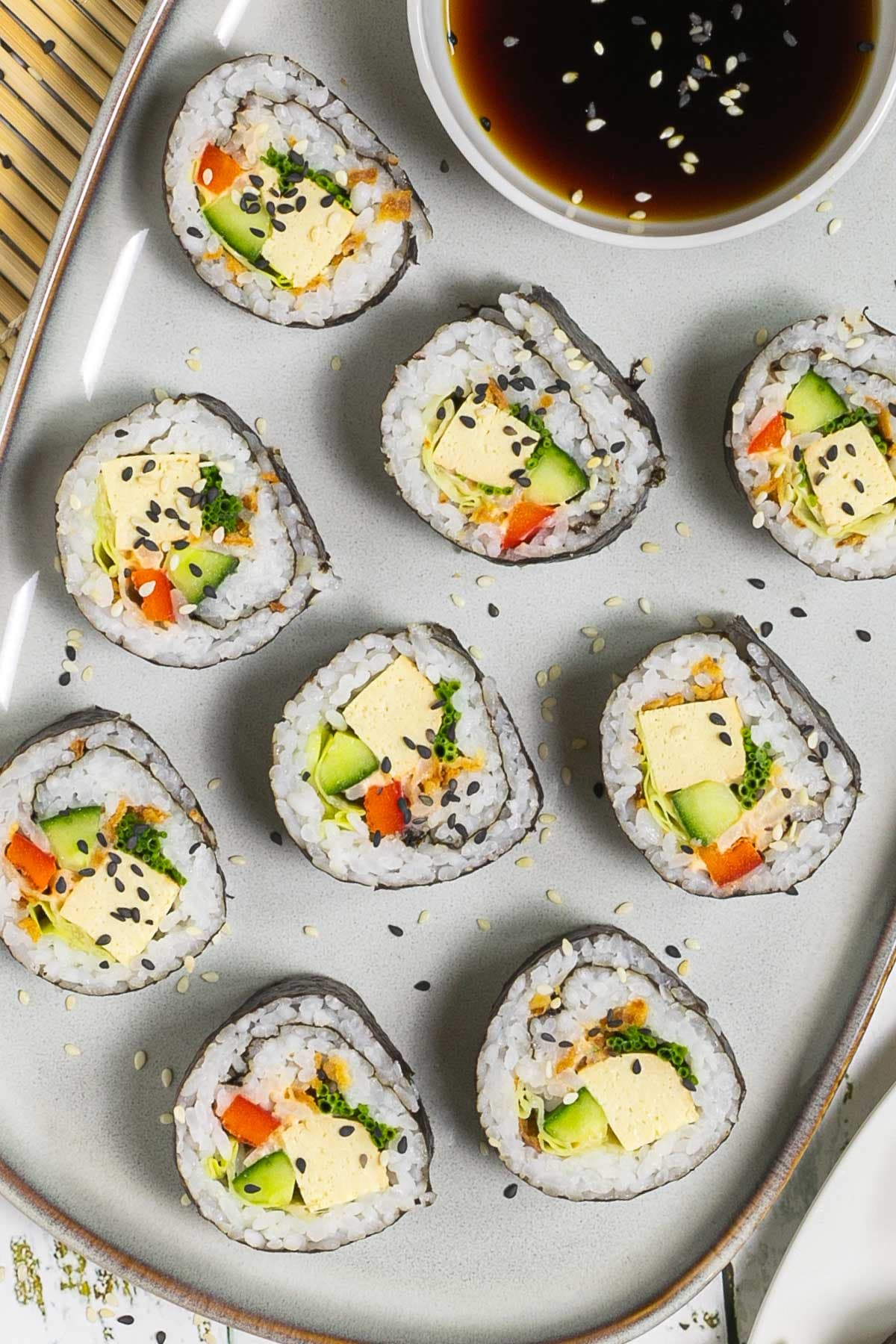
Gobo Sushi
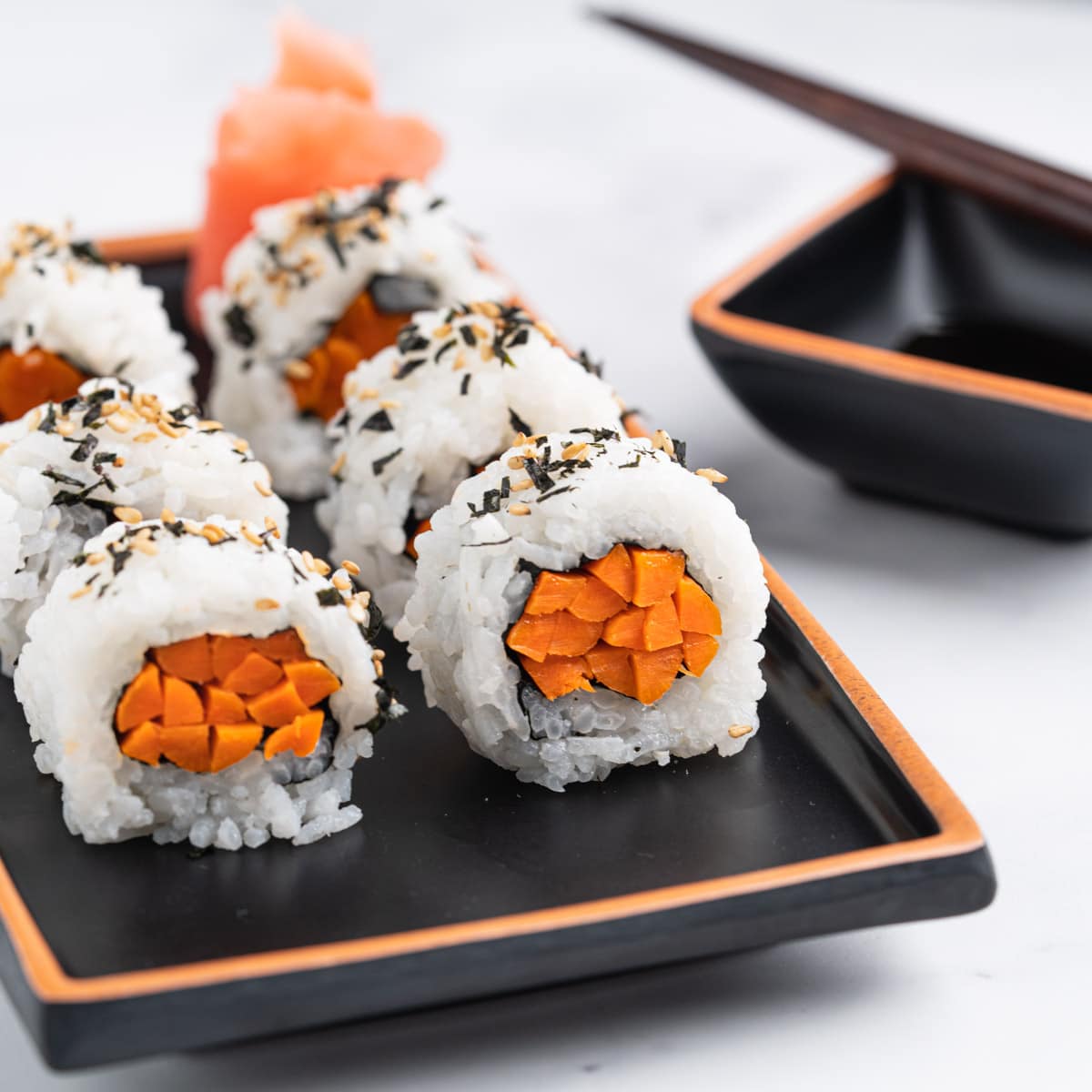
Gunkan Maki
Gunkan-maki (軍艦巻) is a type of nigiri that consists of a minced topping instead of a single large strip on top of the rice, and it’s wrapped in nori seaweed. Gunkan means “warship,” which refers to the shape of the roll, as you can see below.
Konjac Gunkan Maki Sushi
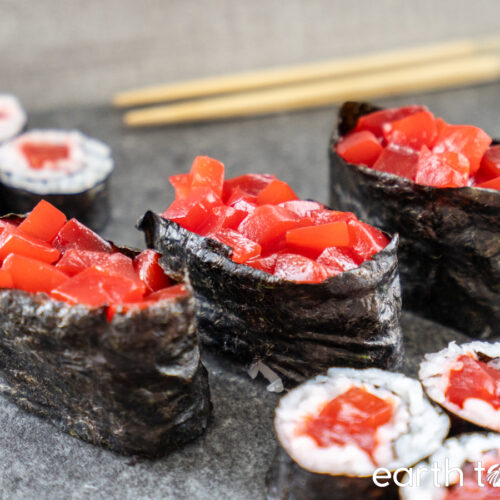
“Tuna” Gunkan Maki Sushi
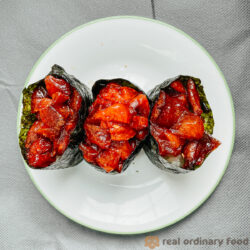
Rice Alternatives
Sushi, by definition, needs to have rice, right? After all, the word sushi (寿司) literally means “vinegar rice” in Japanese. But if you’re looking to reduce your white rice consumption while still enjoying classic sushi flavours, give these a shot.
Sushi Rolls with Quinoa Sticky Rice
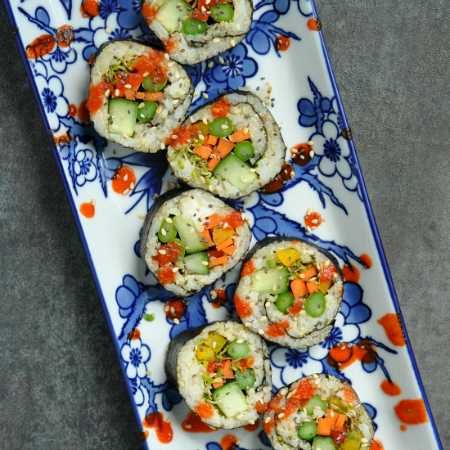
No Rice Almond Sushi

Storebought Brands
Okay, now let’s talk about some commercial vegan sushi products you can find.
VEGEFARM Vegan Unagi
Unlike sashimi, which is raw, unagi (aka barbecued eel) is cooked. It’s a common topping for nigiri and also found on the popular unadon, which is a bowl of steamed rice topped with unagi.
This unagi is sold by VEGEFARM, a brand based out of Taiwan specializing in vegan and vegetarian mock meats. I purchased it from a local store called Homey Food, which carries many imported Taiwanese products.
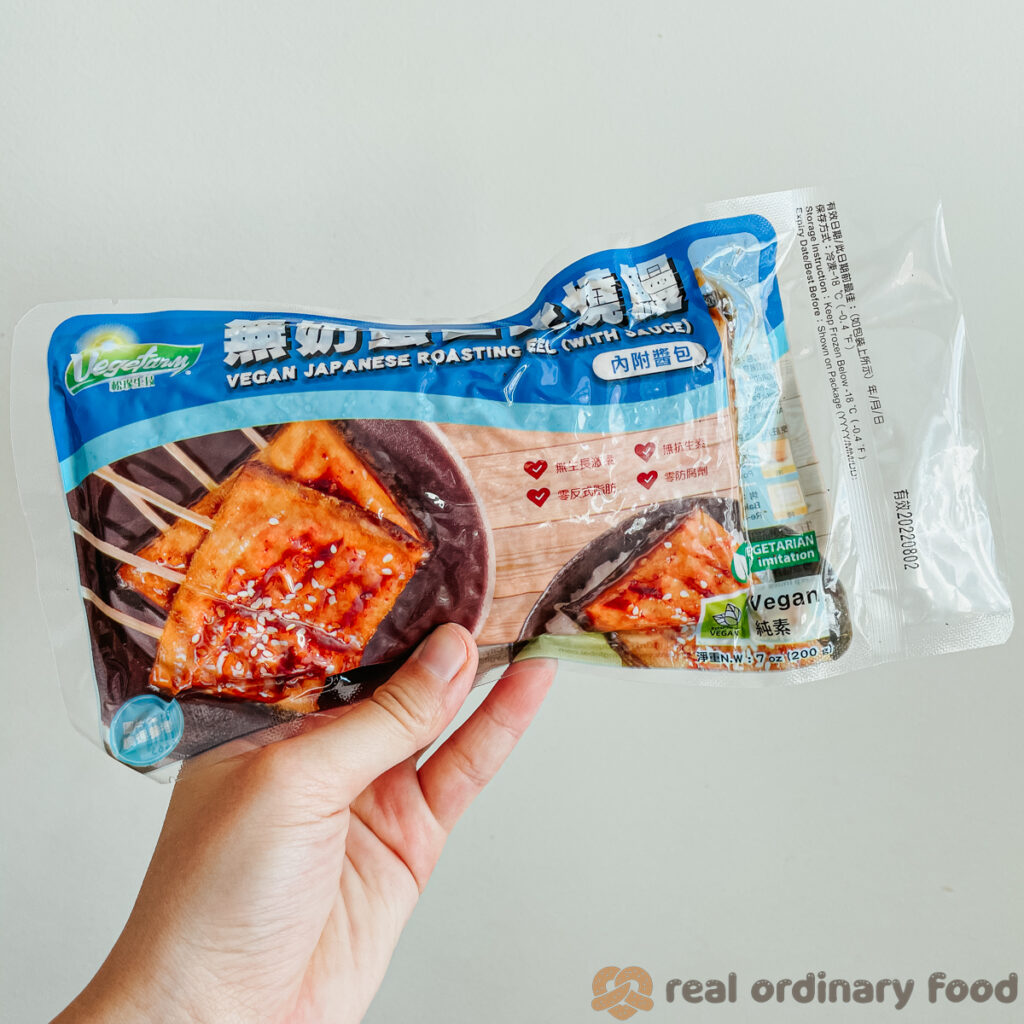
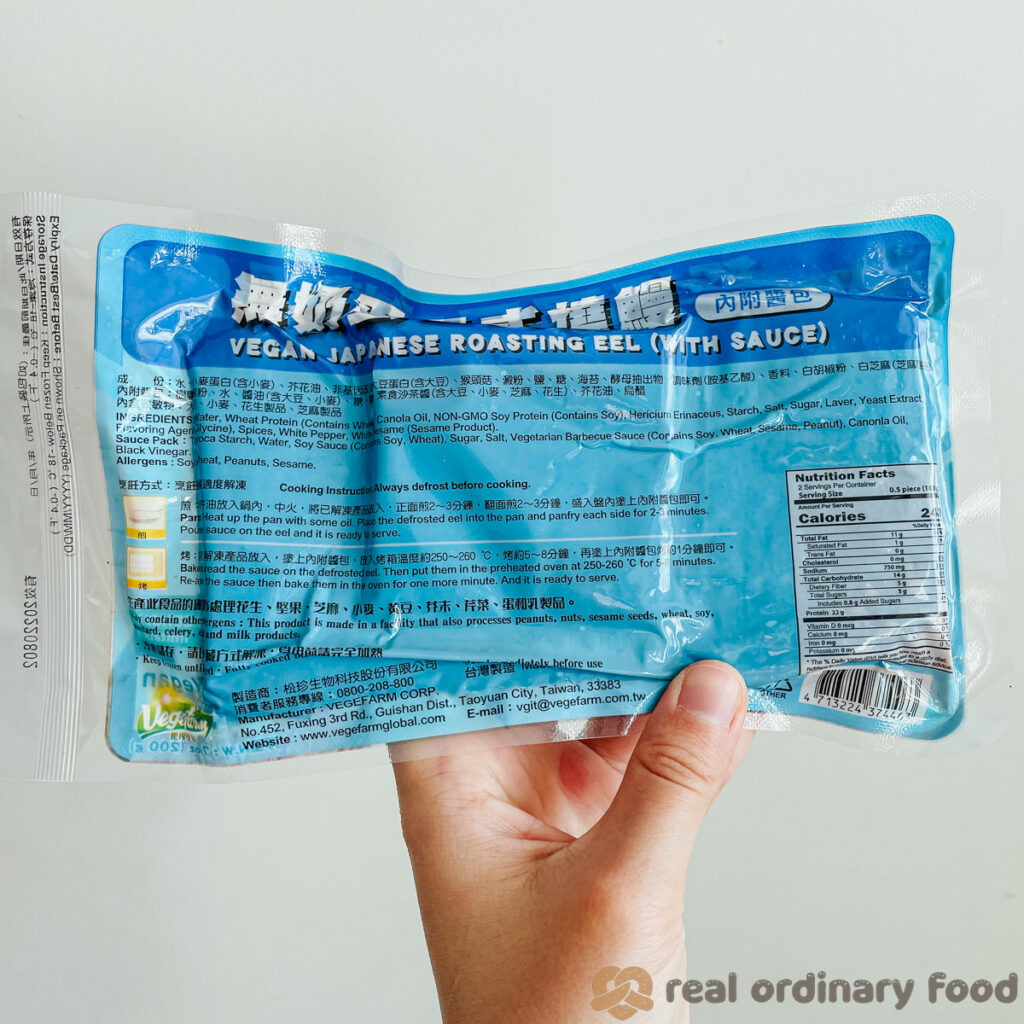
First, the good: this veganized unagi is definitely tasty. It even flakes a bit, like a real fish fillet. The sauce is delicious too. And it packs a protein punch: 22g of protein for a 100g serving (half the package)! Eating this is a very satisfying experience.
The not-as-good: the fish is slightly mushy. The taste and texture actually reminded me more of chicken than fish. Also, while the sauce is good, the fish itself did not have that intense fishy flavour that I associate with unagi. Finally, these were expensive. I don’t remember the exact price but it was upwards of $10 for a 200g package.
Overall, though, it comes somewhat close to the real unagi experience and I would buy it again. I used this in my easy chirashi sushi bowl recipe (below), although it’s pretty good on its own or over a bed of sushi rice.
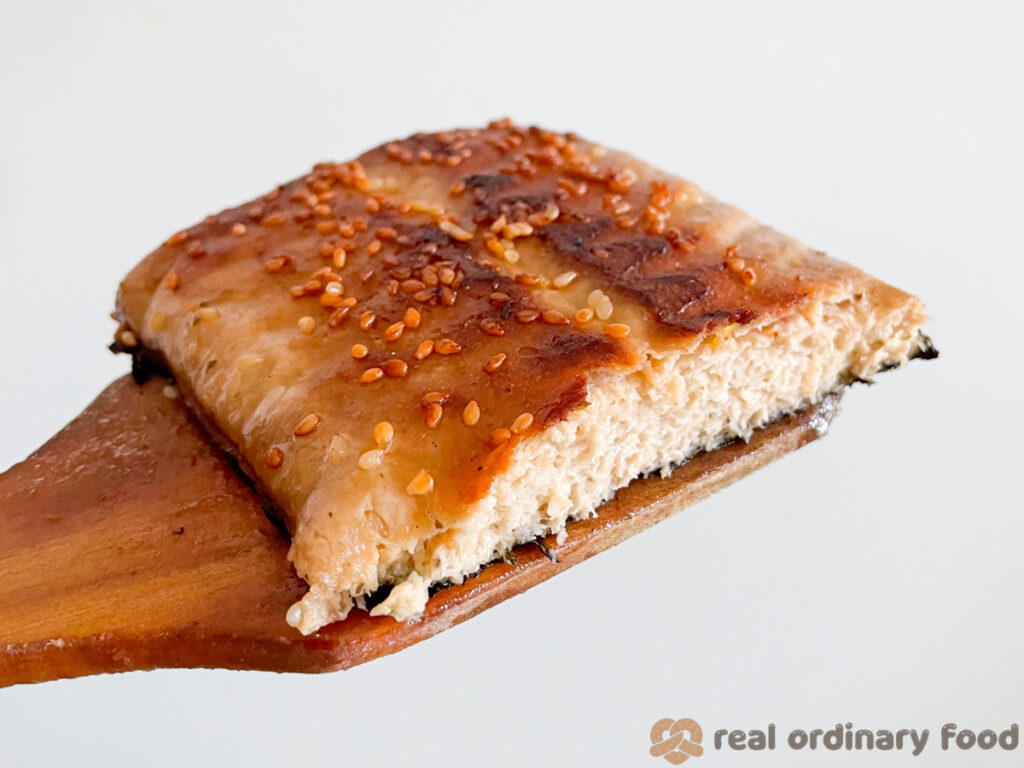
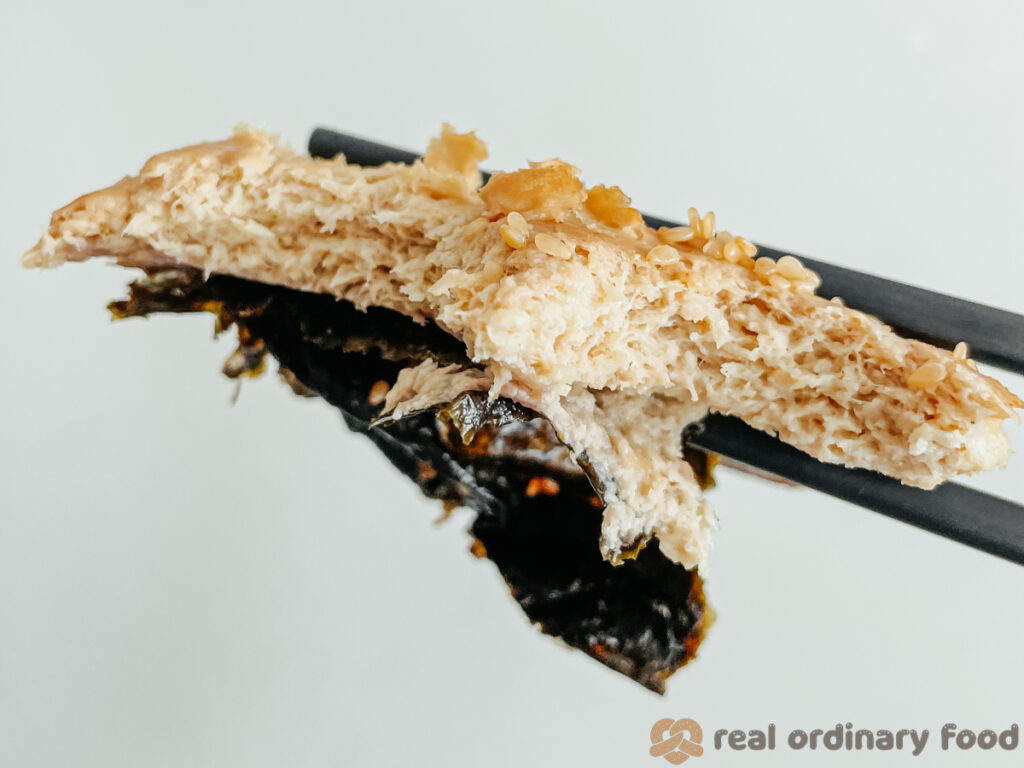
I have a tip if you’d like to try this one yourself: take the cooking instructions on the package as a guideline only. A non-stick pan on the stovetop is easiest but you still need to add oil. Otherwise, it will stick like crazy. Use medium-low to medium heat and don’t try to flip it if it’s still sticking to the pan, or it’ll fall apart. It took me about 5 minutes per side.
VEGE 9 Vegan Sashimi
These salmon and tuna sashimi blocks are sold by the brand “Vege 9, Inc.” another Taiwanese company. They come frozen, but to eat them you need to first thaw overnight in the refrigerator. The packaging says you should finish the sashimi within 2 days of thawing, although I kept one in the fridge for 5 days and it still tasted the same as the one that was eaten right away.
The packaging and presentation of these vegan sashimi is very similar to the “Sashimi No Tuna” and “Sashimi Zalmon” sold by Vegan Zeastar, which I’ve heard a lot of hype about but are not yet available in Canada. Once they start being sold here, I will do a comparison of these two brands. But I couldn’t be happier with these ones from Vege 9!
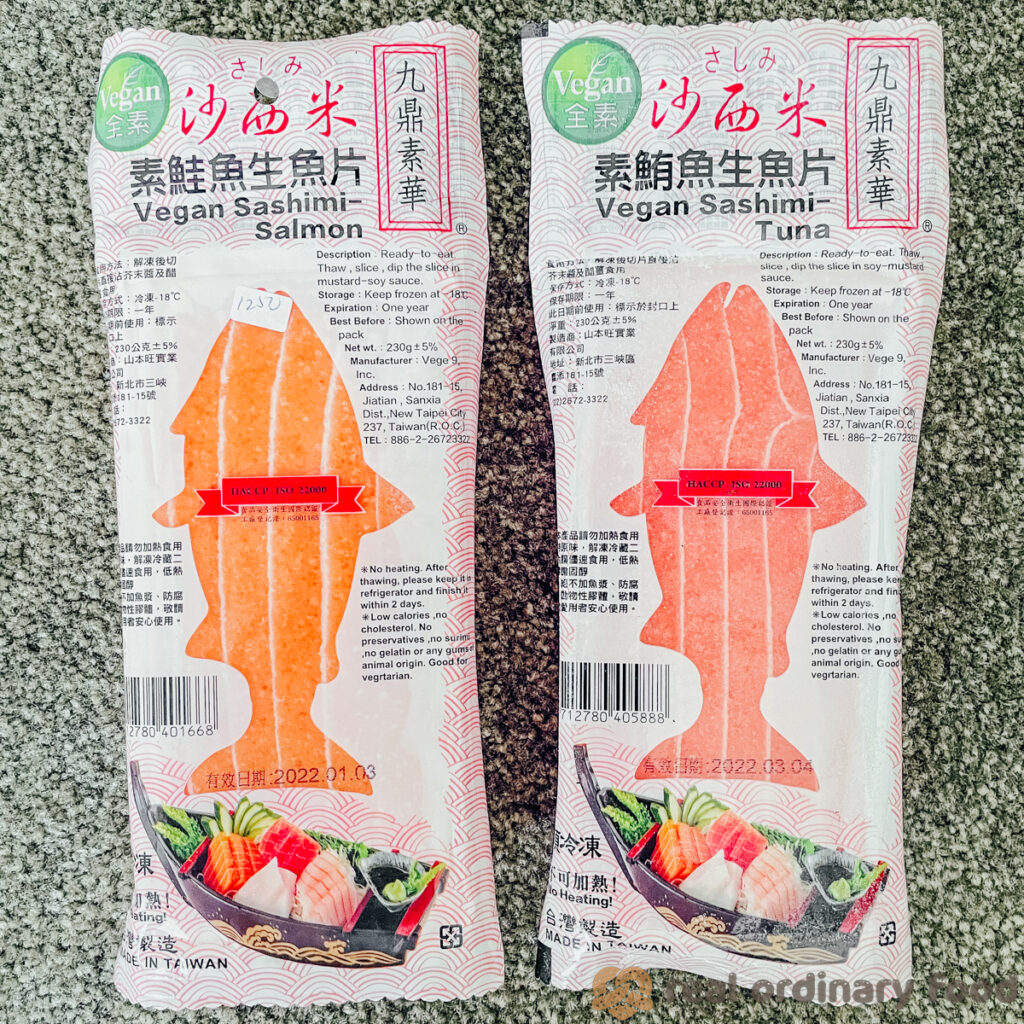
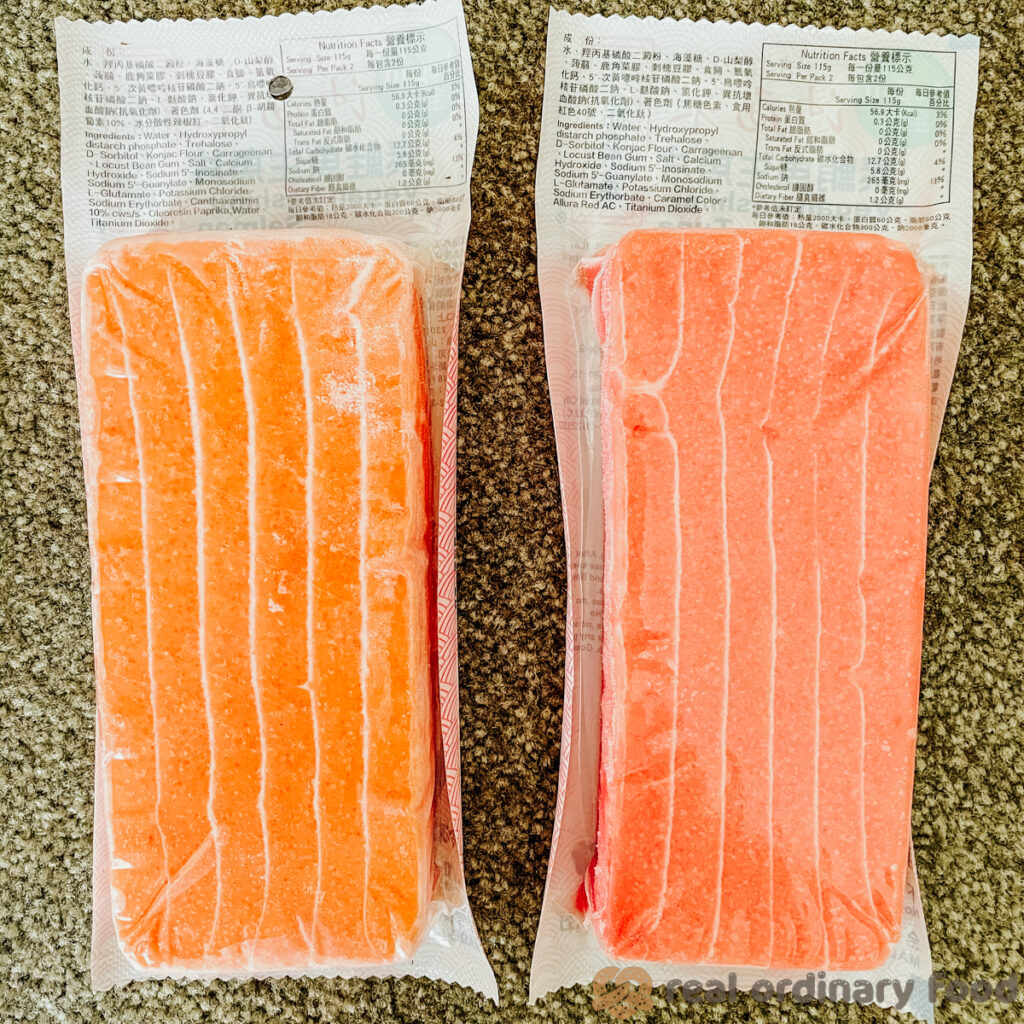
I was blown away by this product. Out of everything I’ve tasted, this was the closest to real salmon or tuna sashimi in taste and texture. (My boyfriend was less enthused, but meh he’s biased against vegan food in general. My mom was just as impressed as I was; she said it tasted super close to actual seafood.) I used them in both a vegan chirashi bowl (recipe below) and rolled up into maki.
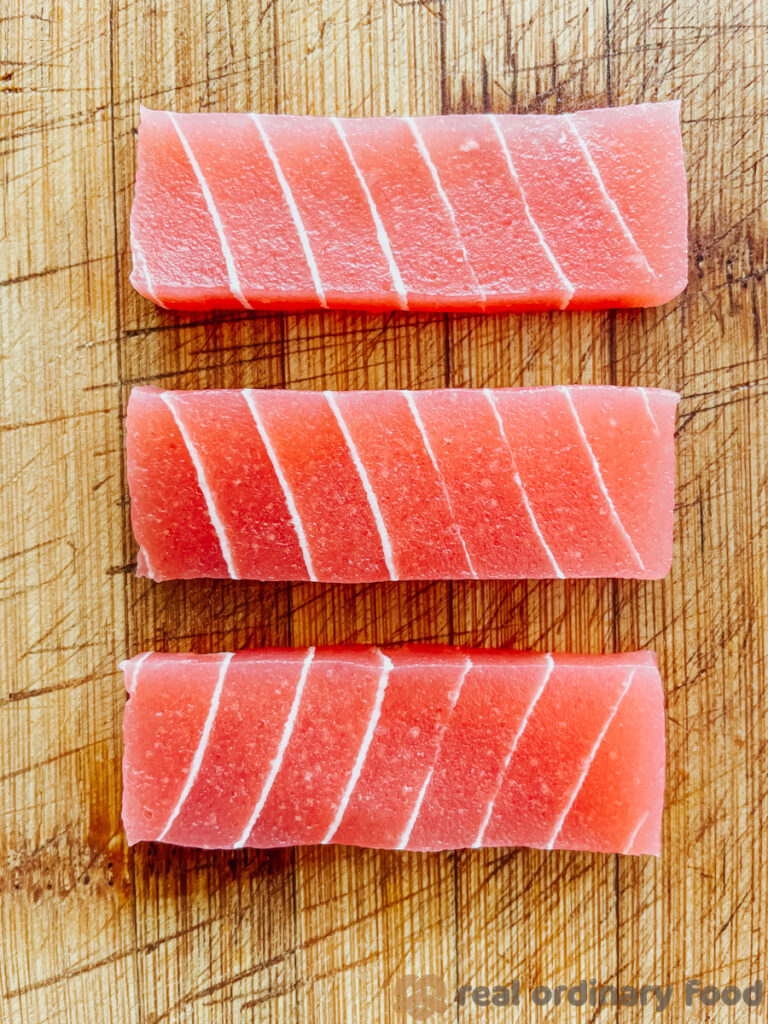
The biggest issue with many homemade sashimi recipes is that they primarily use soy sauce and other strong seasonings to add umami and to mask the flavour of the original ingredient. Raw fish, of course, isn’t saturated with soy sauce and has a more subtle taste. This product mimics that mild flavour—just a hint of salt and something fishy, but not heavily seasoned. The touch and feel of these sashimi blocks is pretty close too; the ingredients list contains konjac flour, locust bean gum, and carrageenan, which account for the firm yet squishy texture. It’s bouncier compared to real sashimi but that’s really not a problem.
And one more bonus, these are incredibly light on calories! Half a block of vegan sashimi, which is actually quite filling, will set you back less than 60 calories.
At $12.50 a pop, these hurt my wallet a lot more than the homemade sushi options. But you get what you pay for, and if you are craving a true sushi experience these will be your best bet. If you’d like something similar without breaking the bank, try my Homemade Vegan Sashimi copycat recipe.
Chirashi Donburi Recipe
Using the salmon and unagi blocks, plus some other fresh veggies, I whipped up this delicious all-vegan Chirashizushi Donburi Bowl. With plant-based alternatives to everything, it’s so easy to go vegan these days even when it comes to sushi!
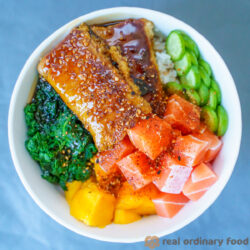
Vegan Chirashi Donburi
Use Imperial/Metric buttons below to toggle between volume vs weight measurements. I recommend weighing out your ingredients for best results.
Ingredients
- 4 oz Homemade Vegan Sashimi approx. 1/2 of the recipe as written; can sub with 1/2 pack of storebought sashimi
- ½ pack vegan unagi see Note 1
- 1 cocktail cucumber, sliced thin
- ½ mango, cubed
- ½ cup wakame seaweed
- ½ avocado
- 1 cup cooked sushi rice
Instructions
- Add sushi rice to a bowl.
- Top with the remaining ingredients.
- Drizzle unagi sauce or teriyaki sauce over the bowl and dig in!
Notes
- The vegan unagi I used (from VEGEFARM) comes with enough barbeque sauce to season the entire rice bowl. If yours doesn’t come with sauce, or it’s not enough, add some extra soy sauce or teriyaki sauce to taste.
Nutrition
Vegan Sushi FAQs
Vegans can enjoy sushi by choosing plant-based options like vegetable rolls with ingredients such as cucumber, avocado, tomato, konjac, and yam or sweet potato maki. They can also explore creative choices like mango rolls or fruit sushi. Inari sushi, made with marinated tofu pockets filled with vinegared rice, is a traditional sushi enjoyed in Japan, and is typically vegan.
Vegan sushi rolls can be a healthy option when they contain nutrient-rich vegetables like avocado, cucumber, and yam. Some rolls are even made with brown rice or alternative grains to increase protein and fibre content. Be cautious with high-sodium sauces and fried components, which can add excess calories and unhealthy fats. Portion control is essential, and it’s best to enjoy them as part of a balanced diet. Ensure awareness of any allergens in the sushi restaurant, and for those with dietary restrictions, making sushi at home allows for greater control over ingredients and preparation methods.
The best vegan sushi varies based on your individual taste, but some classic options are avocado rolls, cucumber rolls, and yam tempura rolls. More creative options include watermelon tuna sushi and tomato nigiri sushi. My personal favourite is inari sushi, which is sushi rice wrapped in savoury and juicy marinated tofu pockets. The “best” choice depends on personal preference, so exploring different vegan sushi options at sushi restaurants or making them at home allows you to discover your favorites.
Good sushi fillings offer a balance of flavors, textures, and colors. Some popular options include creamy avocado, crisp cucumber, and marinated tofu. Other tasty choices are tempura-fried vegetables like sweet potato or asparagus, which provide a crispy contrast to the rice and nori. You can also experiment with more modern creative choices like konjac sashimi or tomato sushi.
Yes, you can make sushi with tofu, and it’s a popular choice for vegan and vegetarian sushi rolls. Tofu can be marinated and prepared in various ways to add flavor and texture to your sushi. Firm or extra-firm tofu or smoked tofu is typically used, so it can be sliced thinly and marinated for added depth of flavor. You can pan-fry, bake, or grill the marinated tofu to achieve a crispy or slightly caramelized texture before using it as a filling in your sushi rolls. This gives your sushi a protein-rich, savory component that complements other vegetables and ingredients for a well-rounded and satisfying roll.
Conclusion
While there is currently no vegan sushi product that can fool a real lover of seafood, the Vege 9 brand products came the closest. The vegan unagi also makes a decent substitute for fans of unagi donburi or unagi nigiri. The homemade tomato, konjac, and watermelon sashimi recipes are much more affordable and accessible for everyday cooking.
If you go in expecting a perfect sashimi facsimile, you’ll be disappointed. If you appreciate them for what they are: creative, unique, and savoury spins on common fruits and vegetables, I’m sure they will make you a wonderful lunch or dinner!
Have you found other interesting vegan sushi or sashimi recipes, or have a product in your country that you want to brag about? Please let me know in the comments.

That donburi looks delicious.
Agreed 🙂
Dear Earth to veg,
Congratulation for your web, I find interesting news and ideas to develop. I was surprised by the vegan sashimi product and I would like to contact the Taiwanese Vege 9 company. Could you help me? Thanks in advance
Hey Maddi, I don’t have any personal connections with Vege 9. But you could try asking Christina Lo, owner of the store that carries these products: https://homeyfood.ca/contact/ She might be able to give you the company’s contact information.